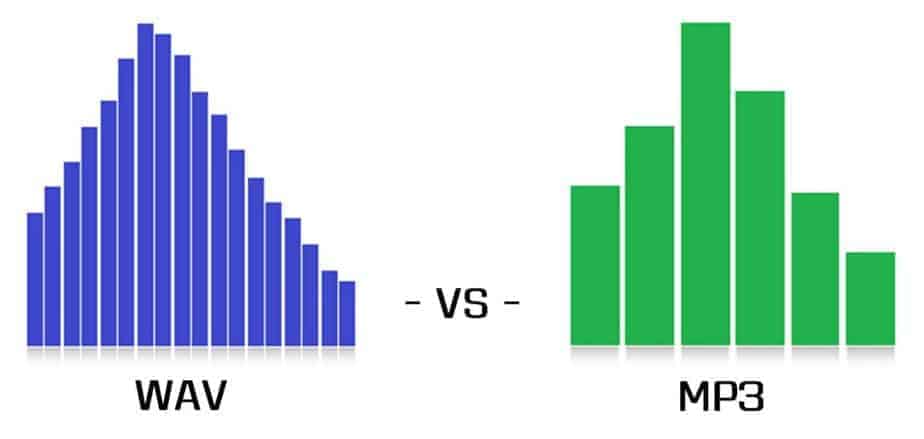
WAV vs MP3 – Beginners Guide
WAV vs MP3. If you are reading this post, I’m sure you have a few questions. What format is better? When to use each format? Or maybe you are just curious and want to improve your understanding. Whatever the reason, we will cover it all in this article.
WAV files are the most commonly used audio format among music producers and audio engineers in the professional music industry due to it’s high-quality. MP3 files are slightly lesser quality but much smaller in file size making it a better option for sharing, streaming, and uploading onto portable devices.
- What is a WAV file?
- How WAV files are encoded
- What is an MP3 file?
- How MP3 files are encoded
- Problems with MP3 compression
- WAV Pros and Cons
- MP3 Pros and Cons
- Which one is better?
- Common Alternative Formats
- Summary
What is a WAV file?
A WAV file is an audio format created by Microsoft and IBM that uses containers to store all audio data such as sample rate, bit rate. A container is a smaller ‘chunk’ of the whole file.
WAV files are also referred to as WAVE files and are exactly the same file format.
Typically, WAV files are uncompressed, meaning a WAV file will contain as much of the audio data that was in the original recording as possible. WAV files are also known as lossless audio files because no data has been ‘Lost’ or ‘Compressed’.
A WAV files ‘Quality’ is determined by the ‘sample rate’, and the ‘bit depth’. Sample rates start at 22,050hz, 32,000hz, 44,1000hz, 48,000hz, 88,200, 96,000hz and go up to 192,000hz, and bit size can generally range from 8 to 32 bits.
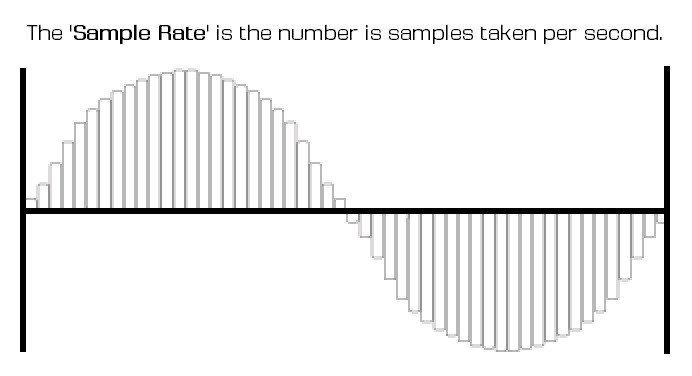
The industry standard is 44,100hz and 16 or 24 bits, but more and more people are starting to record in 32bits.
Because WAV files contain a large amount of audio data, the files can be quite large. The file size can vary quite a lot depending on what sample rate and bit depth are used, but a one-minute audio clip using the industry-standard sample rate and bit depth will be around 15mb.
The human ear can hear frequencies anywhere from 20hz (Very low bass frequency) to 20khz (Very high pitch frequency), and WAV files are designed to capture frequencies over this entire range.
For this reason, WAV files are the most commonly used audio format among music producers and audio engineers in the professional music recording industry.
How WAV files are encoded
Lossless WAV files are encoded using something a called Pulse Code Modulation, or PCM.
PCM measures the amplitude of an analog signal at specific intervals. The encoder then structures the audio data into a digital WAV file.
In a PCM stream, the amplitude of the analog signal is sampled regularly at uniform intervals, and each sample is quantized to the nearest value within a range of digital steps.
The rate at which these samples are taken is determined by the ‘Sample Rate’.
‘Bit depth’ refers to the number of possible values that can be used to represent each value.
What is an MP3 file?
MP3 is a digital audio format designed by the company Moving Picture Experts Group to replicate CD audio quality but with a much smaller file size.
MP3 files are also referred to as MPEG Layer 3 files and are exactly the same file format.
A compressed MP3 file can be as little as 10% of the original WAV file size. This means by using MP3 compression, a 50mb WAV file can be compressed to as little as 5MB.
In order to make the file size so small, some of the original audio data must be removed. This process is called ‘Lossy Compression’ and a byproduct of this compression is a slight loss in audio quality.
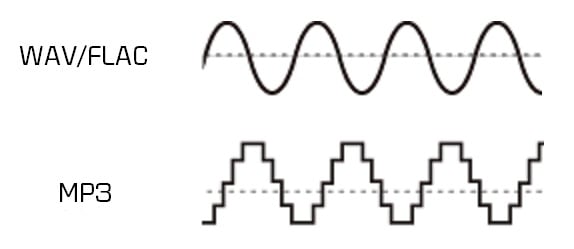
So how does the algorithm know what sounds to remove? Well, that comes down to a process called Temperal Noise Shaping.
Many different MP3 bitrate options are available such as 48, 56, 64, 96, 192, 256, 320 kbps (kilobits per second).
The bitrate refers to how much data is processed per second.
So, in other words, the higher the bitrate, the more data is getting processed and the higher the quality. The lower the bitrate, the less data being processed and the lower the quality.
Uncompressed WAV files are normally 1411kbps, compared to MP3 that can be 320kbps maximum.
MP3 can also use two different types of MP3 compression (Coding) – Constant bitrate, or variable bitrate.
Constant bitrate is exactly that, a constant bitrate through the entirety of the audio clip. This means if an MP3 file is 192kbps constant bitrate, the compression will be at 192kbps through the entire audio clip.
Variable bitrate is a more advanced type of compression where the bit rate will continuously change over time depending on where the coding algorithm feels it requires more or less compression. If the algorithm thinks that certain parts of the song can be compressed to 96kbps and other parts to 320kbps it can do so accordingly.
How MP3 files are encoded
We mentioned earlier that the lost or removed data is determined by the temporal noise shaping process, but what exactly is that?
Temporal noise shaping uses an algorithm that is capable of making a decision of what frequencies to remove from the signal and will only remove frequencies that are barely audible to the human ear.
These algorithms dictate the rules of compression.
There are a lot of different frequencies and data in the background of a signal that the human ear can’t easily hear. These can be removed from an audio signal without significantly altering the sound but still allow for a good amount of compression.
We now know that the human ear can hear the frequency range of 20hz to 20khz. MP3 compression can reduce this range to 20hz to 18khz or even less.
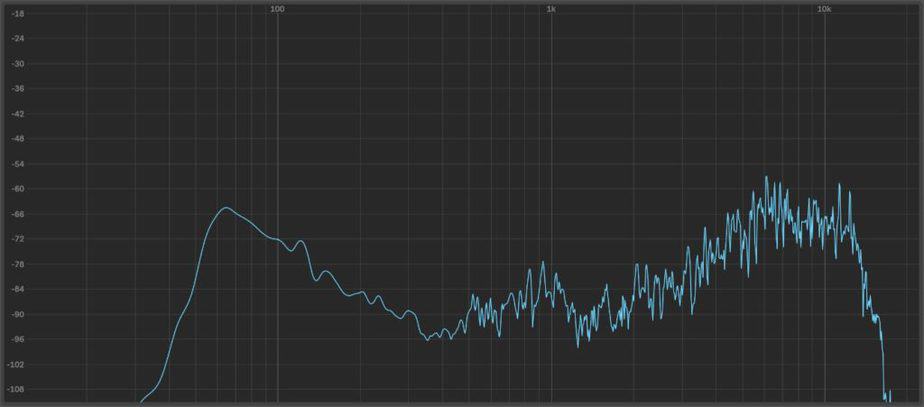
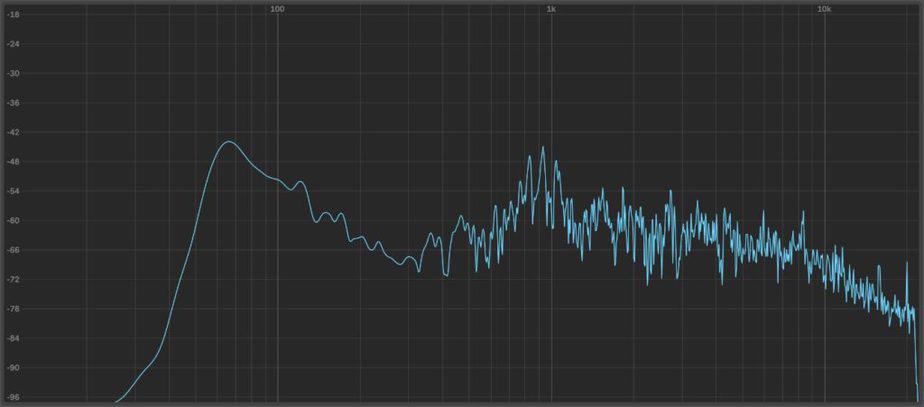
To the average listener, this reduction is probably not audible, but to the seasoned sound engineer or producer, the loss of dynamic range is simply not acceptable.
The different algorithms all have a slightly different character so it’s quite possible to have the same sound processed with different MP3 algorithms that sound slightly different.
Problems with MP3 compression – WAV vs MP3
Because there is a loss of data from the audio signal, there are certain problems that can arise from this compression.
- Weak low and sub frequencies
One of the many problems with MP3 encoding is its ability to turn a rock-solid bassline into a floppy mess.
This is because lower frequency waveforms are quite long so there is very little amplitude difference over the short analysis window the encoder operates in, meaning the bass won’t fully cycle in the time it takes for the algorithm analysis to cycle.
There are much better encoding formats that allow for stronger preservation of low and sub frequencies, for example, the AAC format. Check the ‘Common Alternative Formats’ at the end of this article.
- Reduced Dynamic range
Reduced dynamic range occurs when the compression algorithm removes frequencies that the human ear finds difficult to hear.
The average human is capable of perceiving a dynamic range of 20hz to 20khz.
MP3 compression will generally remove anything above the 18-kHz as these higher frequencies are not as noticeable.
The higher the compression and lower the bitrate, the more the reduction in dynamic range.
- Unwanted noise added
Because the coding algorithms rely on the ear’s inability to hear certain frequencies, noise can sometimes be generated as a byproduct of this encoding that sits in the same place of the removed frequencies.
This added noise can be very difficult to hear for the average listener, but easily visible under closer inspection using a spectrum analyzer.
- Wanted sounds removed
The algorithms used for compression have been told to follow a set of rules and these rules tell them what to remove and what to leave in place.
This is fine under the right circumstances but because the signal input is constantly different the algorithm can sometimes remove sounds that are audible to the listener.
This is why some developers create their own algorithms for audio compression.
- Change in signal volume levels
Because the MP3 encoding removes certain frequencies, this can, in turn, make other frequencies seem a lot louder than they were intended to.
The volume of these frequencies does not increase, it is only our sense perception that tricks our mind into thinking those frequencies are louder than they actually are.
This is called ‘perceived volume’ and is a complex phenomenon not entirely understood by experts.
- Double Speak
Another issue that can arise from MP3 encoding is audio timing errors.
Generally, this artifact is more prominent on vocals and can make a single voice sound like it has been layered, double-tracked, or made robotic.
These artifacts are more noticeable in lower MP3 bitrates.
WAV Pros and Cons – WAV vs MP3
Pros
- High-Quality Audio
The number one reason that all professional sound engineers and producers use WAV files over MP3 or any other file for that matter is its unbeatable audio quality.
Because the WAV format is lossless it retains all quality and information from the original recording.
- Streaming services require WAV
Most distribution agencies require WAV files for music distribution because of its excellent quality.
For example, Amazon Music, Spotify, Apple Music, and many more, all require WAV files. They then convert to another format that is more suitable for streaming.
Cons
- Large File Size
As we mentioned earlier the file size can be quite large in comparison to MP3.
Although they can vary quite a lot depending on what sample rate and bit depth are used, a one-minute audio clip using the industry-standard sample rate and bit depth will be around 15mb.
- Not easy to share
The sheer size of WAVs files can sometimes make sharing these files quite difficult.
Sometimes a song or project can contain 100+ different WAV files adding up to hundreds of megabytes making it difficult to send projects to mixing or mastering engineers over the internet.
- Not good for portable devices
Some MP3 players can only play the MP3 format, but these devices have faded out and the smartphone has taken over.
Smartphones have the capability to play many different formats but because WAV files are very large, only a small amount of data can be stored in comparison to MP3 or some other formats.
Below is an estimation of how many songs can fit on a 64GB device. MP3 vs WAV.
- MP3 – 8000 songs
- WAV – 800 songs
MP3 Pros and Cons – WAV vs MP3
Pros
- Small File size
MP3s are a fraction of the size of WAV files, up to 10% the size.
This makes them extremely efficient when large quantities need to be stored on a small device or laptop.
- Very easy to share
The small file size makes sharing MP3s very easy.
- Good for portable devices
Because of MP3s small file size, they are one of the best options when wanting to store a large number of files onto a small handheld device.
Cons
- Lower Audio Quality
The maximum MP3 bitrate quality is 320kbps.
This is very low quality in comparison to a WAV bitrate of 1411kbps, but still, the average listener would struggle to notice any difference.
- Weak Low End
One of the biggest problems with MP3 encoding is the ability to strip an audio sample of its low end or bass.
This can make the compressed version sound completely different from the original.
- Reduced Dynamic range
Reduced dynamic range is more prominent on lower bitrate MP3 files.
320kbps MP3 files will still maintain a fair about of dynamic range but still not like a WAV file.
Which one is better? WAV vs MP3
There is no definitive answer to this question as each format serves the purpose it was intended for.
WAVs are great for their superb quality and this makes them the best option for sound engineers and music producers.
MP3s are great if you are wanting to share your music, load your music onto a handheld device, or upload your music to your website as it increases page load times.
Common Alternative Formats
- FLAC is gaining more and more traction because of its lossless compression that behaves more like a Zip file. A FLAC file will maintain up to 1024kbps while reducing the file to about 60% of the size making it a great all-rounder format.
- An OGG file is a compressed audio file that is similar to an MP3 file in size but retains better overall quality by encoding with a variable bitrate. This makes it a popular format for streaming services such as Spotify and Google Play Music.
Summary
Well, there you have it. I hope this WAV vs MP3 article has helped provide you with a clear understanding of both WAV and MP3 files and how they are processed and used.
Now you can use this knowledge to make a more educated decision on what format to use in the future.
Want to learn more about audio formats?
As always, good luck and happy producing.